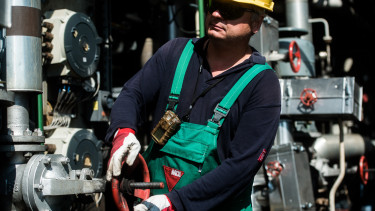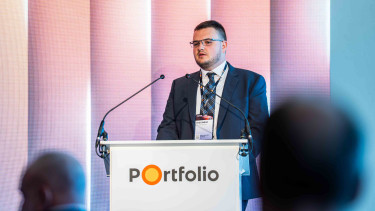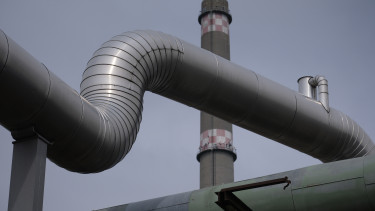2030 emission targets cannot be reached without investing into additional technologies

Why is it important to implement circular economy?
The transition to a carbon-neutral economy is the key in the toolbox to address climate change. But it has been shown by many studies and analyses that this is not feasible by focusing only on the reorganization of energy production. We can take giant steps in a simple way by switching to less carbon-intensive methods in energy production. However, as we move further and further along the road, increasingly difficult and more complex actions are required, and the return on such investment is more difficult to estimate therefore their financing also requires a different approach. Moreover the harsh reality is that many of the new technologies are not mature enough for implementation on a meaningful scale.
The solution must be found in the increasingly complex economic structures, because 45% of greenhouse gas emissions still come from the currently unsustainable extraction and processing of natural resources, that creates additional environmental problems, and is the main cause of the loss of biodiversity and water scarcity.
Demographic projections calculate with growing human populations combined with the doubling of the global consumption of natural raw materials (e.g. biomass, fossil fuels, metals and minerals) in the coming decades, the annual waste generation expected to increase by 70% while the resources of Mother Earth are finite.
In addition to climate change we predict that mankind is heading to another, serious tragedy if we do not take serious and consorted actions. The demand for fossil fuels will decline significantly by 2035 at the latest, while oil companies continue to extract crude on large scale. What can be done with this? Shifting to petrochemicals production (the conversion of petrol products into chemical feedstock) offers an escape route. Most of petrochemical works is about the production of plastics.
Worldwide over $180 billion have been invested by oil companies in building new capacities, which is a long-term investment minimum 20 to 30 years. As a consequence more and more plastic will be on the market, so more and more plastic waste will be generated. The danger is that economic growth will happen in currently less developed poorer countries (in Africa for instance), where, on the other hand, there is no established network for waste management, thereby it will further pollute land and sea. So responsible players must act now. We also have a solution for this.
The new EU leadership has also recognized that “greening” energy production is not enough to tackle climate change and tries to get approval for the European Green Deal. Now the bar is set even higher by proposing the 60 percent carbon reduction by 2030. And there is no doubt that this cannot be achieved simply by increasing energy efficiency and replacing fossil energy sources with renewable sources. The ultimate solution is if circular economy is implemented and operated on global and industrial scale. That means to focus on the entire life cycle of products, designs have to ensure that the resources used are kept in the economy for as long as possible. Or if we can’t do that, e.g. in the case of single-use plastics hygiene needs and the pandemic have shown that they can’t be replaced in the short term, make them recycled based instead of fossil based. Circular economy processes can reduce emissions of greenhouse gases significantly. If the EU votes in favour of 60% reduction, it has to move to circular economy with full speed.

What is the current status of this in Hungary, and what could be the next step?
The EU published its Circular Economy Action Plan on 11 March. Right after that every country in Europe went into lockdown. Significant resources went into solving the pandemic issues in the first and also in the second wave. So there was not much time left nor resources for governments to move with the implementation. But the most important steps should be to regulate producer liability and reorganize the waste management strategy. There were a few key steps leading to the right direction. The EU in order to have its own resources for the € 750 billion coronavirus stimulus package instituted a new tax on single-use plastics from 1 January 2021. This will increase the cost of these materials by at least 30 to 40%. So it already encourages companies to switch to recycle or renewables based raw materials if possible.
Why producers are reluctant to switch to renewable raw materials in production without “plastic tax”? Is the investment cost too high?
To build up a plastic production capacity the investment cycle is 10 years and the cost is billions of Euros or dollars. If a large company starts to think about it now it could go online 10 years later. The current capacities were built in the 1970s and’ 80s for billions of euros.
Quite a few plants have recently been refurbished, which means they will be operational even in the next 30-40 years. On this scale, with this level of efficiency, they will not be able to start a new investment now.
They are also processing millions of tonnes of raw materials. In the short term technologies are not yet at the level where these companies can produce from renewable raw materials on a comparable scale on the existing infrastructure. And this transition cannot be advanced on a purely market basis. The producers also have to work together with their suppliers to make sure the process works seamlessly.
But there is progress and there is a great example even in Hungary. New Energy Kft., an innovative company pioneered the transition of car tires to circular economy. They are able to transform car tires back to raw materials such as oil, carbon black, and steal. And they teamed up with one of the world's leading chemical companies, BASF to advance circular economy. BASF is also a pioneering company in sustainable production of chemicals and an innovator in circular economy strategies around plastics. The oil is fed into the integrated chemical plant of BASF, to create new plastics that are identical with products made out of virgin fossil based material. The produced carbon black is used to make new tires, and the steal is recycled by the metal industry. Currently BASF makes packaging material from the tire oil feedstock, but there are also plans to manufacture auto parts later. New Energy can now process 20 percent of Hungary's tire waste so by building a few more plants the entire country could go circular on tires. The system is ready to be rolled out in other parts of the EU and outside. So if it is adopted on pan European level, the 3.4 million tonnes of waste tire generated in the EU annually would be no longer waste but a renewable source of raw materials. This would also mean that at least 4 million tonnes less crude oil would have to be extracted annually to equip cars with tires in the EU. This is the impact a real circular economy program could have, conserve natural resources, save carbon footprint, create jobs. And this can be done a commercial basis.
Are there any other projects in DBH that has similar impact?
There are many interesting innovations for circular economy in Hungary. Another important trend that can reduce carbon footprint is the switch to compostable plastics made out renewable raw materials. For example, Hungary with its advanced agricultural production capabilities could be a perfect place for the production of lactic acid-based biopolymers that is made out of corn, wheat and fibers. It does not require food grade grains because contaminated materials destined to be destroyed could be used. The so-called “Biorefinery” technology is ready, it just needs to be implemented. This may also have an additional and significant carbon footprint reduction because due to lack of large scale production capacity in the EU, raw materials for compostable plastics are imported from China, Taiwan and the USA, while the demand for it is growing due to the more stringent plastic regulations. The coronavirus epidemic has also exposed the risk of the long supply chain if an economy is relying on key supplies form other continents. In addition, 3D printing using biopolymers has also a very serious growth potential.
There are also many innovative companies experimenting in the field of waste management in Hungary. However the greatest climate impact on virgin material production can come from the metal industry. If the iron industry could be switched to green hydrogen and the aluminium industry to renewable electricity, it could have a huge global carbon footprint benefit. But the carbon footprint reduction potential of the agriculture is another key area that can be addressed.
According to some calculations, switching to a circular economy in the production of five raw materials (steel, cement, aluminium, plastics, food) could save as much emission as the emissions of the entire transport sector combined annually.
The construction industry is one of the most problematic sectors, either in terms of built in carbon or waste management. What should be changed in this?
Cement also has a significant carbon footprint. So replacing it with renewables could result in significant reduction, but there is enormous potential in the construction of zero- or positive energy buildings. Essentially, the carbon footprint of all of the current manufacturing process as well as carbon footprint of the raw materials need to be reduced.
It is not obvious for the public that a new average electric car takes as much carbon footprint to make it that equals to driving it for 150,000 km.
But if the automotive industry use plastic that has been chemically “recycled” from plastic components or from tire it could also significantly reduce the carbon footprint of automotive manufacturing.
It is predicted that by 2040 the number of cars will be doubled and there will be 2 billion cars in operation worldwide. Considering 1,5t weight on average, this will require over 3 billion tonnes of materials such as iron, aluminium, copper, all kinds of plastic, rubber, etc. That is the scale that we would need to further extract from mother earth. Implementing circular economy solutions and increasing the recycling rate for most of the parts would spare an additional few billions tonnes of natural resource and also reduce the carbon footprint of new cars produced significantly. Fortunately some of the carmakers are taking this opportunity seriously, but the supporting recycling technologies need to be further developed, then the cars need to be designed with this objective, and it has to be implemented in the production and the entire supply chain.
Sustainability is getting into the board room discussion in leading companies worldwide. Another and very important key driver for this is that customer’s expectations also seem to be changing. Younger generations are more climate cautious about their purchasing decisions. And market leaders are addressing this. Just a few examples: IKEA has announced that after 2030, it will only incorporate plastic into its furniture that is made from either organic or recycled materials.
Unilever is on the way to replace its fossil-based detergents and other products with bio-based materials within a decade, and will also sell them in containers made out of 100% recycled plastic. Others are also following it and today leading brands already pledged to replace more than 11 million tonnes of virgin plastics in their products within a decade. And this will be increased over the next few years, so the market demand is also catalysing circular economy.
What role do governments play in achieving sustainability goals?
An obvious example is plastic tax. Those plastic producers who already implemented recycling processes on industrial scale can avoid the tax and will have a competitive advantage but those who were not that proactive are scratching their head how stay competitive on a crowded market.
The $180 billion investment in plastics production capacity is much higher than the total Hungarian GDP. But with the shift towards circular economy due to regulations and customer preferences would result in lower demand for virgin plastics that will force investors to rewrite their business case. They will face a different market dynamics and the ROI may be much lower.
According to some forecasts, there is an increasing risk that in the future fossil-based plastics investments will become the same stranded assets as the investments in the oil industry. BP announced $ 13 billion write-off in Q2 and will shift all new investments towards renewable energy. So not investing in additional capacities to make at least partially recycled plastics instead of virgin plastic became the new risk for plastic producers. And that is good for the environment.
Regulating the financial market also holds a great potential to catalyse the shift to circular and greener economy, e.g. the National Bank of Hungary (MNB) is also proactively considering how to implement regulations for the financial sector towards sustainability. Their toolbox kit include monetary policy calibrating prudential regulation, drawing up recommendations and issuing warnings. Adequate rules enable the key players to act in a manner that achieves environmental sustainability objectives. They can give priority to green programs and to ensure that investment projects serving environmental sustainability and environmentally sustainable economic activities are faced with a consistently more favourable financing environment than ‘non-green’ activities. There are already success stories. From 2020 capital requirements on housing loans related to energy efficient residential buildings have been made much more favourable compared with other, ‘non-green’, homes. As for circular economy the system is more complex, and roles are expected to be drawn in 2021. It is very likely, that the proactive and progressive work of the MNB will make them a leader in the region and among the V4 countries’ central banks as well.
Is that enough for the 60% reduction in greenhouse gas emissions set in the 2030 Green Deal?
Unfortunately not. This is because there is a huge gap between the goals set and the current level of technologies that could address circular economy.
We need to develop them further that requires more investment and effort as well as collaboration. We are also working on a Sustainable Development Fund that would address these issues. However we focus on advancing sustainable development and circular economy on the basis of business dynamics and market economics. At the same time there is certain uncertainty in the expected market environment. Recycling regulations are not harmonized, and there are countries in the EU where the waste management system will change. The existing locked waste incineration infrastructure could also be a market barrier, because there is opposing business interest and lobby activity to the expansion of recycling. All of this requires serious coordination and the political will but the outcome is not fully predictable.
What companies does DBH Investment invest in with regards to sustainability? Are there any criteria set for the investment?
Sustainability has always played an important role in DBH's business strategy, and we have now institutionalized these in the Sustainable Development Venture Capital Fund. The aim is to accelerate the technological transition and multiply the beneficial sustainability effects at the same time with commercial returns. We approach sustainable development as a business opportunity. Potential investors are private or international businesses and institutional investors who have long term interest in sustainable development. Environmental but also Social and Governance (ESG) factors are built into the investment decisions and KPIs.
Essential criteria is the ability to reach quantifiable environmental benefits through the development and marketing of the technologies or services. Quantitative KPIs may include carbon footprint reduction, waste reduction, reducing the harmful health effects of climate, or any other quantifiable environmental benefits. The shift to circular economy typically provides these benefits.
We already discussed the role of business and governments. But what can regular people do? If I have a choice between glass bottles, plastic bottles and aluminium can, which is better?
Aluminium has significant carbon footprint compared to the other two, but the choice between glass and plastic is not straightforward. Glass is much heavier, so if the product requires transport, while the plastic is made of recycled one, plastic may be less harmful, but if it is a virgin plastic bottle, glass is usually better and easier to keep in circulation. However, if you have an effective system for plastic collection and recycling, it may be a better choice. Unfortunately for the consumers to decide this would require information that is not yet available. If the regulation would be further developed and made it mandatory to indicate not only the composition of a given product but also its carbon footprint, consumers would be able to prioritize the environmental benefits into their purchasing decisions. There are however some general roles that consumers can apply. Typically it is better to buy or use a product made from renewable raw materials, and we should extend the lifetime of the product and the materials it is made from.
If people buy organic or environmentally friendly product, it is very likely to have a smaller environmental footprint. Locally produced products are better as they do not need to be transported to a long distance. But people can also contribute to the environment by using shared or public transport, electric car, and proper insulation of houses.
The pandemic has slowed down the economy. What is the effect on sustainability?
During the lockdowns, certain old habits were broken and the new way of doing business were advanced. After the lockdown some of these were reversed, but some that were beneficial for the environment remained. Most of the businesses now realized that home office can be just as effective as office work, but the negative effect of long daily commutes is gone. If it is solidified on the longer term it will help reducing transport related emissions. Many people switched to bicycle that also transform cities towards sustainability. The slowdown in aviation will also lead to a significant reduction in the carbon footprint. And the massive effort to shorten the supply chain and transportation routes is also a big shift towards sustainability. It is essential that these positive actions are solidified and become the new standards. But there is tremendous pressure that once the crisis is over, these could be reversed because it was more comfortable, efficient and cheaper. However more harmful to the environment.
What do we expect from each actor in the future?
It is very urgent and important to implement on large scale and adapt the EU’s circular economic action plan since the green transition of the energy sector is not enough to achieve the ambitious goals. At the moment circular economy seems very complex and it is less competitive compared to the linear economy models. Fortunately the combination of regulation and market pressure makes businesses to come up with action plans that results in carbon footprint reduction. But individual decision and actions are almost as important. This can be strengthened by appropriate education. And the most important drivers could be the climate conscious consumer behaviour. As the population will grow the most effective solution is sustainable consumption in combination with sustainable production.
Cover photo: Getty Images












